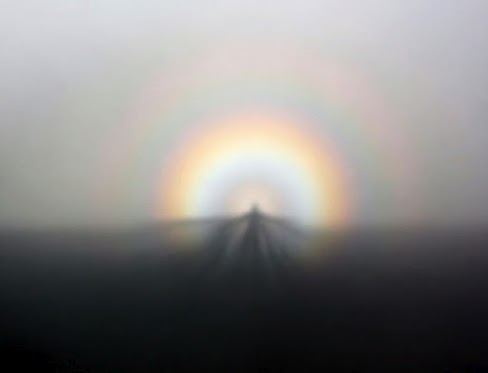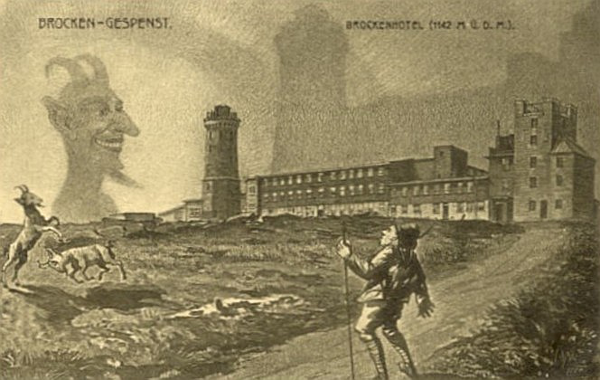David Foster Wallace, Thomas Pynchon and the Brockengespenst
There is an incident in David Foster Wallace’s “Infinite Jest” (1996) that is a direct reference to Thomas Pychon’s “Gravity’s Rainbow” (1973). I believe though that this is actually part of a chain of references going back to Goethe.
In this scene from Infinite Jest, two characters on a mountain top are making shadows in the rising sun:
Marathe watched a column of shadow spread again out east over the desert’s floor as Steeply got a hand under himself and rose, a huge and well-fed figure tottering on heels. The two men sent together a strange Brokengespenst-shadow out toward the city Tuscon, a shadow round and radial at the base and jagged at the top, from Steeply’s wig becoming uncombed in his descent.
Infinite Jest, p. 89

The allusion is to this scene from Gravity’s Rainbow 1:
… Here are Slothrop and the apprentice witch Geli Tripping, standing on top of the Broken, the very plexus of German evil, twenty miles north by northwest of Mittelwerke, waiting for the sun to rise. …
As the sunlight strikes their backs, coming in nearly flat on, it begins developing on the peal cloudbank; two gigantic shaows, thrown miles overland, past Clausthal-Zelterfeld, past Seesen and Goslar, across where the river Leine would be, and reaching toward Weser. … “By golly,” Slothrop a little bit neros, “it’s the Specter.” You got it up around Greylock in the Berkshires too. Around these parts its is known as the Brockengespenst.
… They are enormous, dancing the floor of the whole visible sky. He reaches underneath her dress. She twines a leg around one of his. The spectra was red to indigo, tidal, immense, at all their edges. Under the clouds out there it’s as still, and lost, as Atlantis.
Gravity’s Rainbow, p. 335
A few pages earlier there is this bit of conversation between Geli and Slothrop:
“Have you been up to the Brocken yet?”
“Just hit town, actually.”
“I’ve been up there every Walpurgisnacht since I had my first period. I’ll take you, if you like.”
Gravity’s Rainbow, p. 326
In the introduction to his book of short stories, “Slow Learner” (1984), Pynchon mentions the book, “The Berkshire Hills” (1939), which was produced as part of Federal Writers’ Project of the Works Progress Administration for Massachusetts. That book contains a mention of the Brockengespenst:
Thirty years ago, at the end of the summer season, a Berkshire man was bringing down the piano from the little recreation house atop the mountain. Suddenly he saw himself, his horse and wagon and the piano standing upright, outlined in monstrous design against the sky. Unable to decide whether he had quaffed too much from the “cup that cheers,” he is said to have fled in haste from the mountainside to the minister, and taken the pledge at once.
The phenomenon of a gigantic shadow of an object reflected in a cloud is so well known as to have a German name, the Brockengespenst (Specter of the Brocken) from Brocken, the highest peak of the Hartz Mountains. As Greylockgespenst would be a bit unwieldy for Berkshire, here it is simply called the Specter. C. H. Towne tells more about it in his Autumn Loitering. 2
The Berkshire Hills, p. 42
It’s clear that Pynchon initially found the reference to Brokengespenst from his fascination with Berkshire book, but note the occult aspects he introduces: Geli being a witch; satyric entwinings; Walpurgisnacht, etc. These elements are not part of the Berkshire Hills background story.
Pynchon is known for his wide-ranging references, so it’s impossible to say exactly where he was introduced to the German mythology surrounding the mountain. I believe there is a connection to Nabokov however.
There is a oblique reference to The Brocken in Nabokov’s “Pale Fire” (1961):
During the fortnight that I had my demons fill my goetic mirror to overflow with those pink and mauve cliffs and black junipers and winding roads and sage brush changing to grass and lush blue flowers, and death-pale aspens, and an endless sequence of green-shorted Kinbotes meeting an anthology of poets and a brocken of their wives, I must have made some awful mistake in my incantations, for the mountain slope is dry and drear, and the Hurleys’ tumble-down ranch, lifeless.
Pale Fire, p. 141
Here the protagonist, Kinbote, is in essence comparing Shade’s wife - a rival for his affections - to a witch.
As a student at Cornell, Pynchon attended Nabokov’s lectures while he was teaching Russian and European literature. There is speculation that his character Blodgett Waxwing from Gravity’s Rainbow is a reference to the famous opening line of Pale Fire’s poem 3. Could Nabokov’s reference to The Broken have induced Pynchon to dig deeper into its inherent paganism?
Nabokov was obviously aware enough of The Broken to produce such an arcane neologism with its biting implication of witchcraft. It is understood that this is a direct reference to Goethe’s “Faust”. Even the use of the word “goetic” (~Goethe) in the same paragraph referenced above hints at this.
Goethe described the Brocken in his “Faust” (1808), as the center of revelry for witches on Walpurgisnacht.
Now to the Brocken the witches ride;
The stubble is gold and the corn is green;
There is the carnival crew to be seen,
And Squire Urianus will come to preside.
So over the valleys our company floats,
With witches a-farting on stinking old goats.

Note: I was tempted to try and find a link to Thomas Mann’s “The Magic Mountain” (1924), and its references to Walpurgisnacht, through there was nothing obvious, it is easy to imagine that it influenced Pynchon or even Nabokov, despite his noted criticism of him.
1 Wallace himself confirms this in an interview from 1997:
“That thing in Infinite Jest where two representatives (Steeply and Marathe) of two countries are on a cliff-side and are making enormous shadows and playing with it — and there’s even the use of the word Brockengespenst, which comes out of Slothrop and Geli Tripping (from Gravity’s Rainbow) fucking on the Brockengespenst— that’s an outright allusion.”
2 I could find no reference to this book anywhere. Update: the book is actually called “Autumn Loiterers” by Charles Hanson Towne:
As I have said, it was sunset time, and the hills were a riot of colour. It is on a high mountain near Williamstown, so the legend has it, that a certain man may be seen moving at the close of day—moving his furniture in a great van, a giant illusion, due, it is said, to some mysterious atmospheric condition. We did not see this monstrous phantom, though I confess that, having heard of it, I was humanly curious about it. Perhaps the atmospheric conditions were not right. If that is so, I am glad; for a more perfect afternoon I have never known, and I would rather experience reality than an illusion.
Autumn Loiterers, pp. 79-80.
3 Pale Fire, Canto 1:
I was the shadow of the waxwing slain
By the false azure in the windowpane
I was the smudge of ashen fluff—and I
Lived on, flew on, in the reflected sky,








The three men I hate the most: David Foster Wallace, Thomas Pynchon, and fucking Don McLean.
» Posted by Anonymous on December 7, 2012 09:25 PM